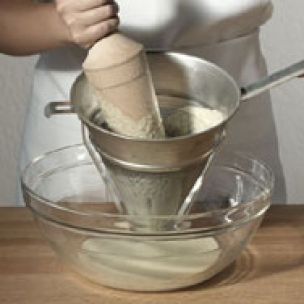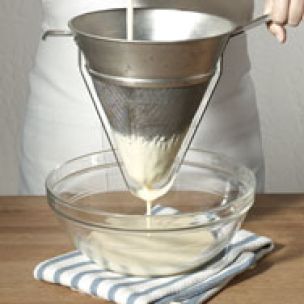Using a Chinois

Stocks
To filter and defat a homemade stock, set the chinois over a large bowl. Then carefully pour the stock and its contents into the cone. Most of the liquid will pass through the mesh, but the solids left behind still hold flavorful juices. Using the pestle, press the solids to release these juices.
Let the strained stock come to room temperature, then refrigerate it until the fats solidify, about 2 hours. Skim off the fat and refrigerate or freeze the stock until ready to use.

Pureed Soups and Sauces
To create fine-textured soups with delicious combinations of flavors, simmer vegetables, spices, herbs and oils with a stock or broth. Then, once the flavors have developed and the vegetables are tender, puree them in a blender or food processor. To ensure the soup's clean, velvety texture, remove vegetable seeds and herb stems by passing the soup through a chinois into a clean pot. Use the pestle to break down the larger vegetable pieces and force them through the mesh. The same method can be used for saucesfrom pan-juice reductions to a classic beurre blanc.

Custards and Curds
When making a custard or curd, you'll want the texture to be silky and smooth. These sauces often turn out slightly lumpy due to the egg or starch cooked in the sauce, but this can easily be remedied by passing them through a chinois. Pour the sauce into the chinois over a clean large bowl. Then, using the pestle, press any solids that remain.